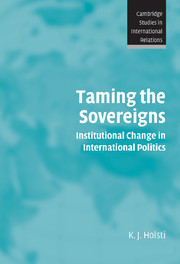Book contents
- Frontmatter
- Contents
- List of tables
- Preface
- 1 The problem of change in international relations: rhetoric, markers, and metrics
- 2 States and statehood
- 3 Territoriality
- 4 Sovereignty
- 5 International law
- 6 Diplomacy
- 7 International trade
- 8 Colonialism
- 9 War
- 10 International institutions: types, sources, and consequences of change
- References
- Index
- CAMBRIDGE STUDIES IN INTERNATIONAL RELATIONS
10 - International institutions: types, sources, and consequences of change
Published online by Cambridge University Press: 22 September 2009
- Frontmatter
- Contents
- List of tables
- Preface
- 1 The problem of change in international relations: rhetoric, markers, and metrics
- 2 States and statehood
- 3 Territoriality
- 4 Sovereignty
- 5 International law
- 6 Diplomacy
- 7 International trade
- 8 Colonialism
- 9 War
- 10 International institutions: types, sources, and consequences of change
- References
- Index
- CAMBRIDGE STUDIES IN INTERNATIONAL RELATIONS
Summary
We have now examined eight international institutions. More would be possible, but they are not necessary to allow us to make some judgments about one important marker of change in international politics. This concluding chapter has five purposes:
to map, collectively, the pattern of institutional change in international politics over the past three centuries, approximately;
to evaluate the types of changes in these institutions;
to offer judgments about the degree of institutionalization in each domain of international politics;
to outline some of the sources or explanations of change; and
to explore the “so what” question: do institutions matter?
Table 10.1 summarizes the discussion of the foundational and process institutions.
All four foundational institutions were new in the late seventeenth and early eighteenth century. They had no precedents in European or world history. All have changed in the past three centuries, but the main type, with the exception of territoriality, has been complexity, not transformation or obsolescence. The state, for example, has taken on many new tasks and functions, developed ever-expanding sources of revenue, and instilled loyalties that were unknown or only nascent three hundred years ago. Yet, its late seventeenth-century antecedents are clearly recognizable as states. They had many of the same functions, although more limited in scope, and they had institutional continuity not typical of earlier types of polities. Similar comments could be made for sovereignty and international law.
- Type
- Chapter
- Information
- Taming the SovereignsInstitutional Change in International Politics, pp. 300 - 323Publisher: Cambridge University PressPrint publication year: 2004

